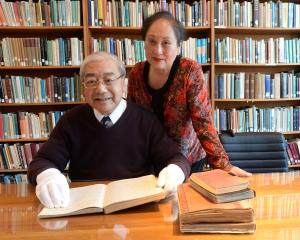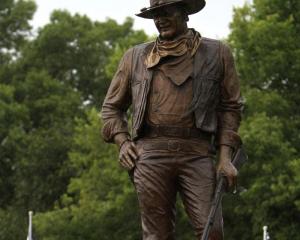Think head cold.
"Your face gets kind of puffy," said Gerald Carr (78), who once spent 84 days orbiting Earth, as I picked at a piece of Nasa-made red velvet cake.
"But you become used to it."
And launching? "Like you're riding on a train with square wheels," he said.
"It's noisy, bumpy and busy. You're too busy to enjoy the ride."
It was a Tuesday afternoon in a Kennedy Space Centre banquet room on Florida's salty-aired, sun-kissed Atlantic coast.
Forty visitors and I were there for the daily "Lunch With an Astronaut" and for an hour Gerald Carr, silver hair setting off his grey Nasa jacket, was our astronaut.
The two pads from which every shuttle mission has launched sat a few kilometres away.
So did the control room where the United States first sent a man into space, and the site of the 1967 Apollo 1 fire that killed three astronauts during a training exercise.
I would be seeing all those.
For the moment, my Nasa visit was chicken with mushroom sauce, vegetable medley, jugs of Tang (a reference seemingly lost on youth) and Carr, a former Skylab commander who visited space in the mid-1970s.
But for all his tales from orbit, it didn't take long to reach the issue at the forefront of Space Coast minds these days: the end of Nasa's space shuttle programme.
The once-proud programme has fired its last shot for now, 50 years after Alan Shepard became the first American in space, igniting a nation's imagination and giving central Florida an international tourist attraction 10 years before Disney World popped up 80km west.

"For many of us, this is not very palatable," Carr said.
"But it's the decision that has been made."
The other is that for the first time in decades, Nasa and its partner agencies have no clear mission.
Layoffs are expected, and a question is raised: What will become of tourism at the sprawling Space Coast beyond the occasional unmanned rocket launch?
Although the hotel- and restaurant-filling pilgrimages to watch shuttle launches obviously will disappear, the two days I spent on the Space Coast demonstrated that Nasa and the Kennedy Space Centre remain well positioned to attract those fascinated by America's history of space exploration.
There are tours, simulations, history lessons, lectures and, yes, lunches with astronauts.
And where else are you going to stand beneath the wide, black-tiled belly of a life-size training shuttle? Or walk the same orange metal bridge that Neil Armstrong, Michael Collins and Buzz Aldrin crossed to enter Apollo 11 for the first moon landing? "When we were growing up, this was all very real to us," said Tony Deliseo (44), a software engineer from Sydney who was crossing that bridge with his family in the indoor-outdoor visitors complex.
"It was a global event."
Although excited to be at the centre, Deliseo admitted he would be less likely to visit without a shuttle programme.
"This won't be news any more - it will be history."
And that is exactly what looms.
Unless a sexy new programme, such as commercial space travel or something Mars-bound, comes along, the Kennedy Space Centre probably will make the transition from a living part of history to a museum.
But it will make a heck of a museum.
Before my lunch with an astronaut, I wandered among America's earliest rockets, tall as buildings and well-kept, even if to modern eyes they seemed borrowed from a 1950s movie set.
A kid there, about 10, wore a mock white spacesuit with unselfconscious pride.
Later that afternoon, I headed out on the two-hour "Discover KSC" tour on a bus of about 40 filled seats and a tour guide who, like many of his grey-haired brethren, had an 8-year-old's enthusiasm for America's space history.
As we set out, he asked what Velcro, smoke detectors, cable television and cellphones have in common.
"We wouldn't have any of that without Nasa," he said.
"And Nasa gave it to the world, not just America!" We went from the visitors centre to the heart of Kennedy Space Centre, where the vehicle assembly building adorned with an American flag and Nasa logo loomed.
That's where shuttles have been mated with their fuel tanks and solid-fuel rockets.
We passed the launch pads that have sent shuttles into space, and there I learned something: the Kennedy Space Centre has had two shuttle launch pads, commonly called launch pad A and launch pad B.
For its first nine lift-offs, Challenger left from launch pad A.
For its 10th and fatal launch, it departed from launch pad B.
It was a nearly three-hour tour, that tapped into modern US space history.
The next day I joined an even longer tour of adjacent Cape Canaveral, seeing where the earliest US rockets launched.
That tour took us into the control room that sent the first American rocket into space.
It took us to the control room that controlled Shepard's launch.
It took us to the exact spot where Apollo I caught fire; they asked us to remove our hats for that one.
The Cape Canaveral tour was nothing but history, which seemed encouraging for the future of the Space Coast.
Even after the end of the shuttle programme, anyone with a sense of space history will still find something there.
Jeffrey Shankman, visiting with his family from Johannesburg, reasoned that the end of the shuttle programme could even be good for tourism.
"It could make it more popular," he said.
"We cling to our past. You only realise what you have when it's taken away."
A classic, and often true, point.
Nasa's most encouraging sign seemed to be in the parking lot as I headed home.
Most of the tourists streaming to their cars did so with plastic bags stuffed full of mementoes from the gift shop.
They wanted a piece of space to take home with them


